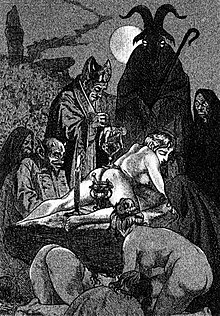| Revision as of 06:01, 25 September 2012 edit206.255.121.244 (talk)No edit summaryTag: reference list removal← Previous edit | Revision as of 06:02, 25 September 2012 edit undoFrosty (talk | contribs)Extended confirmed users, Pending changes reviewers, Rollbackers43,249 editsm Reverted edits by 206.255.121.244 (talk) to last version by ClueBot NGNext edit → | ||
| Line 1: | Line 1: | ||
| ], of a '']'', in the 1911 edition of ''La Sorcière'', by ].]] | ], of a '']'', in the 1911 edition of ''La Sorcière'', by ].]] | ||
| Witchcraft is a book by Jules Michelet on the history of witchcraft, published, originally in French language, in 1862. The first English translation was published in London in 1863.<ref>''La Sorcière: The Witch of the Middle Ages'', translated by L. J. Teotter, "The only Authorized English Translation", London, 1863.</ref> According to Michelet, medieval witchcraft was an act of popular rebellion against the oppression of feudalism and the Roman Catholic Church. This |
'''''Satanism And Witchcraft''''' (originally ''La Sorcière'') is a book by ] on the history of ], published, originally in ], in 1862. The first English translation was published in ] in 1863.<ref>''La Sorcière: The Witch of the Middle Ages'', translated by L. J. Teotter, "The only Authorized English Translation", London, 1863.</ref> According to Michelet, medieval witchcraft was an act of popular rebellion against the oppression of ] and the ]. This rebellion took the form of a secret religion inspired by paganism and fairy beliefs, organized by a woman who became its leader. The participants in the secret religion met regularly at the ] and the ]. Michelet's account is openly sympathetic to the sufferings of ]s and women in the Middle Ages. | ||
| According to Michelet, in a note added to the end of the book: | According to Michelet, in a note added to the end of the book: | ||
| Line 9: | Line 9: | ||
| In the early 1970s, ''La Sorcière'' became the basis for the ] film, '']'' by ]. | In the early 1970s, ''La Sorcière'' became the basis for the ] film, '']'' by ]. | ||
| ==See also== | |||
| *'']'' | |||
| *] | |||
| ==References== | |||
| *English translation: ''Satanism and Witchcraft: A Study in Medieval Superstition''. Transl. ]. Lyle Stuart/Citadel Press, 1939. | |||
| *''La Sorcière de Jules Michelet: l'envers de l'histoire'', ed. Paule Petitier. Paris, Champion, 2004. | |||
| {{reflist}} | |||
| ==Sources Online== | ==Sources Online== | ||
| Line 16: | Line 26: | ||
| * | * | ||
| * | * | ||
| {{DEFAULTSORT:Satanism And Witchcraft}} | |||
| ] | |||
| ] | |||
| ] | |||
| ] | ] | ||
| ] | ] | ||
Revision as of 06:02, 25 September 2012

Satanism And Witchcraft (originally La Sorcière) is a book by Jules Michelet on the history of witchcraft, published, originally in French, in 1862. The first English translation was published in London in 1863. According to Michelet, medieval witchcraft was an act of popular rebellion against the oppression of feudalism and the Roman Catholic Church. This rebellion took the form of a secret religion inspired by paganism and fairy beliefs, organized by a woman who became its leader. The participants in the secret religion met regularly at the witches' sabbath and the Black Mass. Michelet's account is openly sympathetic to the sufferings of peasants and women in the Middle Ages.
According to Michelet, in a note added to the end of the book:
- The object of my book was purely to give, not a history of Sorcery, but a simple and impressive formula of the Sorceress's way of life, which my learned predecessors darken by the very elaboration of their scientific methods and the excess of detail. My strong point is to start, not from the devil, from an empty conception, but from a living reality, the Sorceress, a warm, breathing reality, rich in results and possibilities. (Michelet, p. 326)
The first part of the book is an imaginative reconstruction of the experience of a series of witches who lead the religion from its original form of social protest into decadence. The second part is a series of episodes in the European witch trials. Today the book is regarded as being largely inaccurate, but still notable for being one of the first sympathetic histories of witchcraft, and as such it may have had an indirect influence on Wicca.
In the early 1970s, La Sorcière became the basis for the anime film, Kanashimi no Belladonna by Mushi Production.
See also
References
- English translation: Satanism and Witchcraft: A Study in Medieval Superstition. Transl. A. R. Allinson. Lyle Stuart/Citadel Press, 1939.
- La Sorcière de Jules Michelet: l'envers de l'histoire, ed. Paule Petitier. Paris, Champion, 2004.
- La Sorcière: The Witch of the Middle Ages, translated by L. J. Teotter, "The only Authorized English Translation", London, 1863.
Sources Online
- The full French text (various formats)
- The full French text, with internal links and pictures (MS Word format)
- Full text of "La Sorcière: The Witch in the Middle Ages" (1863 English translation)
- Same text (Online book format)
- Illustrations by Martin van Maële from 1911 Edition
This article about a non-fiction history book is a stub. You can help Misplaced Pages by expanding it. |